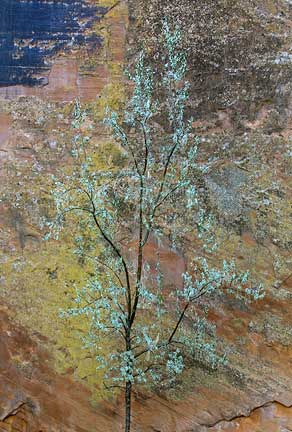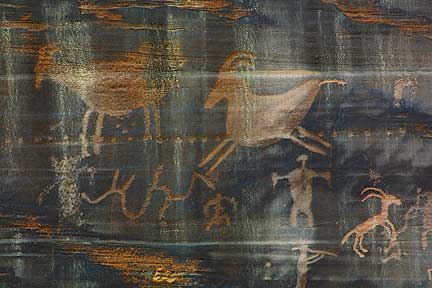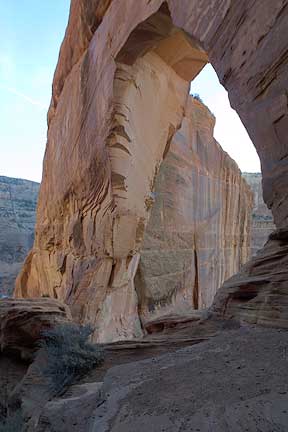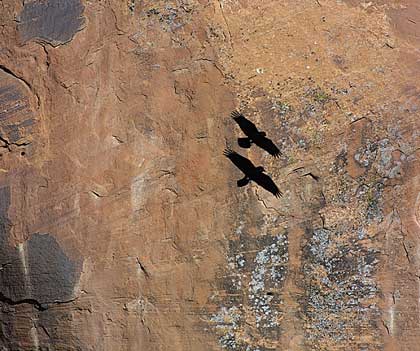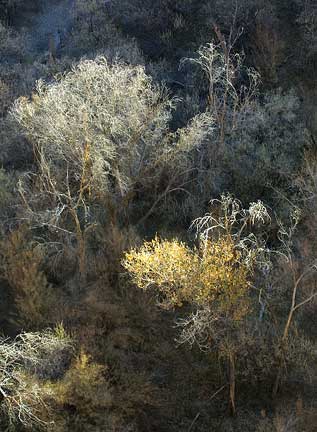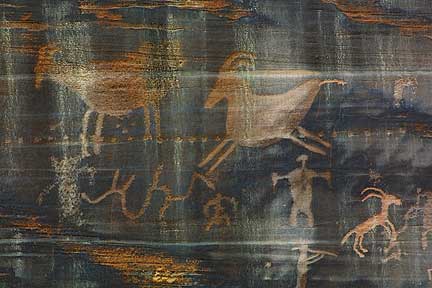

This subject is featured in Issue #4 of The Luminous Landscape Video Journal.
A Second Visit
In the spring of 1999 I paid my first visit toCanyon de Chelly. You can read about that visit and view the small portfolio from ithere. This National Monument is in the heart of theNavajo Nation,and though it is one of the most beautiful parks in the country it is also one of the least visited because of its remoteness. This return visit was part of an exciting photographic trip throughIndian Country.
My first visit was much too short and so in December 2000 I returned, and was able to spend a day and a half in the company of my friend and fellow landscape photographerAlain Briot. Alain has lived for the past five years inChinle, the town located at the entrance to the Park, and so knows the park and surrounding areas well. You can view Alain’sGuest Portfoliolocated on this site and also visithis own siteto see his excellent work.
Flaming Tree
Photographed with a Canon EOS D30 and 100~400mm f/5.6L lens at ISO 100. RAW Mode.
This was one of the first frames of the trip, shot early on my first morning atCanyon de Chelly. From one of the overlooks on the South Rim you look down some 500 feet to the valley floor below. Here, shortly after dawn, a shaft of sunlight illuminates a lone tree in the middle of the wash.
Russian Olive
Photographed with a Canon EOS D30 and 70~200 f/2.8L lens at ISO 100. RAW Mode.
Because we had expressed an interest in Rock Art our Navajo guide stopped along the way though the valley and helped us cross a fence to where some pictographs were located. While the Rock Art was excellent I was stunned by an absolutely lovely Russian Olive Tree growing right next to this colourful cliff face. This has turned out to be one of my favourite images from the trip. A true case of serendipity.
CDC Pictograph 1
Photographed with a Canon EOS D30 and 100~400mm f/5.6L lens at ISO 100. RAW Mode.
There are several locations with petroglyphs within the Canyon. When we asked our guide to take us to some he stopped at a spot that none of us had seen before. Crossing a fence he explained that he belonged to a family from that area and therefore was allowed onto the private land behind the fence.
The rock face was very high up the cliff face. Having the equivalent of 640mm at the long end of the zoom was really helpful in terms of being able to get close-ups on some of the details, like this one showing long-horn sheep.
For more about pictographs and petroglyphs you may want to look at the section of this portfolio onRock Art.
The Window
Photographed with a Canon EOS D30 and Sigma 14mm f/2.8 lens at ISO 100. RAW Mode.
Half way up the Canyon on the way toSpider Rocklies a feature calledThe Window. This huge arch is located about 400 feet up a steep slope and is itself a couple of hundred feet high. I made it as far as the base ofThe Windowand could go no further. It was simply too dangerous for me, though some in our party made it to a vantage point to the left of the frame above. This allowed looking down through it at the canyon floor below.
Throughout the trip I was frustrated by the lack of an extreme wide-angle lens. The14mm Sigmadid yeoman service but on theCanon D30it is only equivalent to a 22mm lens‚ which really isn’t wide enough for situations like this one.
Two Ravens
Photographed with a Canon EOS D30 and 100~400mm f/5.6L lens at ISO 400. RAW Mode.
As we drove through the valley floor at one point we stopped to watch a small group of ravens soar and conduct mid-air acrobatics with a red-rock cliff as backdrop. Though it was in bright sunlight I quickly switched to an ISO 400 setting and was thus able to pan with the birds at 1/1000 sec @ f/9.5 and still freeze the cliff face as well as the birds.
This image appeals because the birds appear to be flying with the radiating lines on the cliff face, adding an enhanced sense of motion.
Photographed with a Canon EOS D30 and 100~400mm f/5.6L lens at ISO 100. RAW Mode.
From the rim of the Canyon there are fascinating opportunities to photograph the valley floor beneath. Dawn and sunset provide the best times as the light has the greatest contrast. Natural features such as these trees take on an abstract aspect when seen from such an unfamiliar vantage point.

Lorem ipsum dolor sit amet, consectetur adipiscing elit, sed do eiusmod tempor incididunt ut labore et dolore magna aliqua. Ut enim ad minim veniam, quis nostrud exercitation ullamco laboris nisi ut aliquip ex ea commodo consequat. Duis aute irure dolor in reprehenderit in voluptate velit esse cillum dolore eu fugiat nulla pariatur. Excepteur sint occaecat cupidatat non proident, sunt in culpa qui officia deserunt mollit anim id est laborum.
Lorem ipsum dolor sit amet, consectetur adipiscing elit, sed do eiusmod tempor incididunt ut labore et dolore magna aliqua. Ut enim ad minim veniam, quis nostrud exercitation ullamco laboris nisi ut aliquip ex ea commodo consequat. Duis aute irure dolor in reprehenderit in voluptate velit esse cillum dolore eu fugiat nulla pariatur. Excepteur sint occaecat cupidatat non proident, sunt in culpa qui officia deserunt mollit anim id est laborum.
Lorem ipsum dolor sit amet, consectetur adipiscing elit, sed do eiusmod tempor incididunt ut labore et dolore magna aliqua. Ut enim ad minim veniam, quis nostrud exercitation ullamco laboris nisi ut aliquip ex ea commodo consequat. Duis aute irure dolor in reprehenderit in voluptate velit esse cillum dolore eu fugiat nulla pariatur. Excepteur sint occaecat cupidatat non proident, sunt in culpa qui officia deserunt mollit anim id est laborum.

